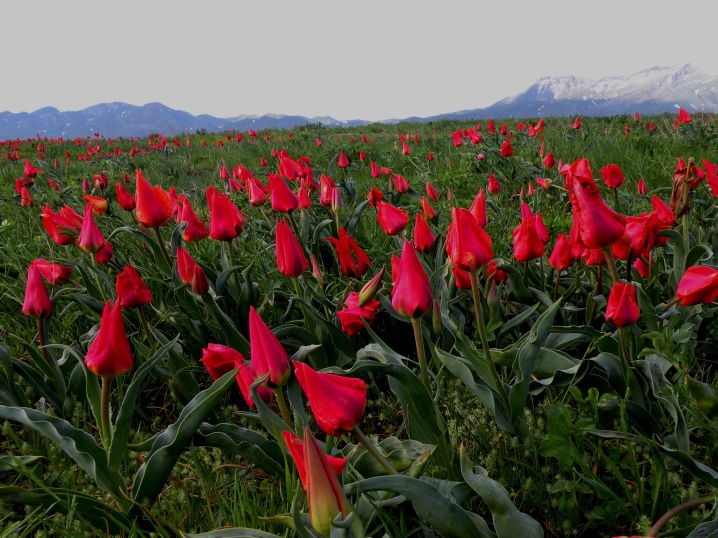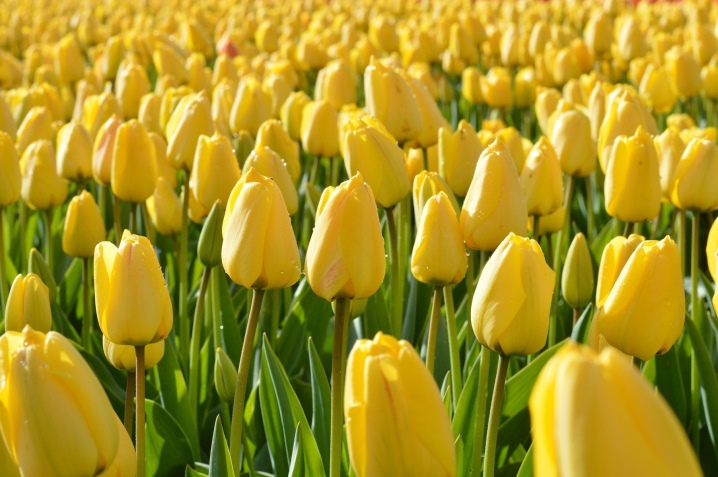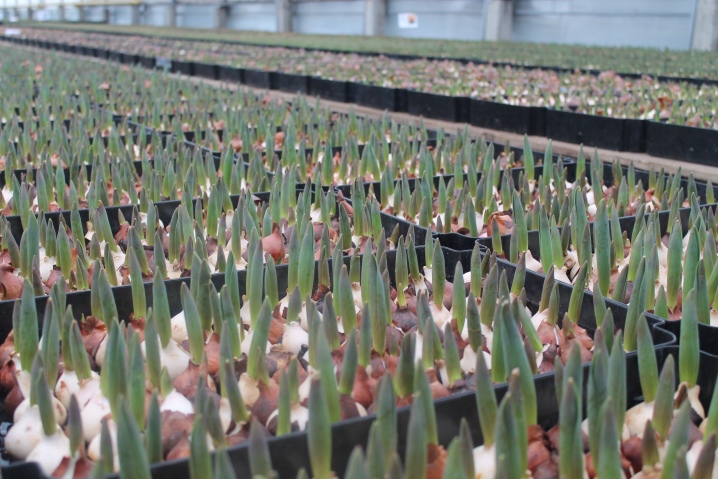How to grow tulips on March 8?

At a time when nature finishes its awakening after winter calm, tulips begin to delight the eyes with colorful, bright flowering. These perennial bulbous flowers are so beautiful that you always want to see their riot colors, and not only in spring. Agricultural technology of tulips allows you to grow these plants all year round, giving yourself not only aesthetic pleasure, but also the opportunity to earn extra money.

Suitable varieties
Growing beautiful and high-quality flowers at home is not as easy as it seems at first glance. This process is very fun, but no less challenging. First you need to choose tulip varieties that are best suited for forcing them under artificial conditions.
It was experimentally found that undersized tulips are most suitable for this purpose.

It is also necessary to take into account the class, color of flowers, susceptibility to their diseases. Of all the varieties of tulips that are especially popular for winter distillation, flower growers have singled out the best. Here are their names.
- Foster's tulip. Its height is 12-16 cm. The plant is highly resistant to diseases.

- Greig's tulip. Gained recognition for its beautiful goblet buds with a monochromatic or two-tone color.

- Crystal. Belongs to the class of double tulips. The spectacular flowers range in shades from red to purple. Resistant to adverse conditions.

- Parade. A hardy and unpretentious variety. The buds have a goblet shape. The flowers are usually red with orange veins.

- Gunders Rhapsody. The height of the plant is no more than 50 cm. The buds gradually change color, from deep pink to milky white with pink blotches.

- White Elegance. The height of the peduncle is up to 60 cm. The lily-shaped bud is ivory-colored. The petals are graceful and refined, pointed at the ends.

- Hemisphere. Chameleon tulip. Delicate flowers are initially milky white with pink touches. After a while, the bud darkens, acquires a deep pink color. Resistant to diseases, characterized by increased endurance.

Preparation
In order for the tulip to bloom by March 8, it is necessary to correctly determine the time of its planting. The most suitable time for this is autumn. It is important that all the necessary materials are prepared by the middle of the fall season.
Forcing "March" tulips should be carried out in mid-October, but not later than the end of the month. Such an early planting is necessary in order to give the plant an opportunity to "rest", to be in a dormant period, which lasts from 3 to 5 months. In flower shops, you can buy ready-made planting material that has already passed the cooling stage. In this case, tulips planted even in January will bloom for the women's holiday.
The preparation of the perennial plant bulbs begins in late summer or early autumn. You can use your own planting material or purchase the varieties you want from specialized flower shops.

In order for the future plant to be healthy and strong, it is necessary to calibrate the bulbs:
- the optimal size of the planting material should be 35-55 mm;
- on the slightly elastic bulb there should be no damage, signs of disease.

Experienced growers use 2 main methods of planting material preparation (cooling), which differ in their storage temperature.
- With the first, shorter-term method, temperature jumps are not allowed, it must be maintained at a constant level: + 5 ° C or + 9 ° C. This causes difficulties and inconveniences when growing flowers at home.
- In the second case, the bulbs are stored for at least 4 months. Temperature fluctuations are permissible within the range from + 6 ° C to + 12 ° C. The first part of this period, the material is stored in a cool place (basement, lower shelf of the refrigerator), the second - in a special substrate, where further forcing of plants will be carried out.
As a container for growing tulips, flower growers use pots, wooden or plastic boxes, and special containers. It is desirable to give preference to natural materials such as clay, wood, ceramics. They have the ability to conduct air, which provides sufficient nutrition for the root system of the flower.

A waterlogged environment leads to rotting of tulip bulbs. Therefore, a mandatory requirement is the presence of drainage holes at the bottom of the container.
With their help, excess moisture comes out of the pot. Tulip pots and containers must be at least 15 cm deep.
Rooting of tulip bulbs must be carried out in a special substrate that has a normal level of acidity and has high fertility rates. You can buy ready-made soil or prepare it yourself. It is not recommended to use pure garden soil: after several irrigations, it becomes compacted and sags.
Florists use 2 types of substrate for growing tulips at home:
- 2 parts of garden land have 1 part of coarse sand and compost;
- 1 part of garden soil and humus (compost) for 2 parts of sawdust.

Planting and leaving
Immediately before planting the planting material in the ground, it is necessary to re-inspect the bulbs. This will allow you to select the healthiest specimens without showing any signs of disease. It is advisable to remove the scales from the bulbs - this will allow them to germinate in a shorter time.
Regardless of the method of growing tulips, it is advisable to pre-disinfect the bulbs. For this, a weak solution of sodium permanganate (potassium permanganate) is used, in which the planting material is soaked for 20-30 minutes. Additionally, the soaking water can be enriched with any growth stimulating agent (for example, "Epin").

This procedure will reduce the risk of diseases of the root system of the plant, as well as accelerate the germination process.
Step-by-step instructions for landing.
- The substrate is poured into a prepared container at? from its height.
- The bulbs are slightly deepened into the soil with their tails up. When planting flowers in large quantities, the distance between the bulbs must be observed: the distance between them must be at least 1-2 cm. They must not be in contact with each other or with the walls of the container.
- Another layer of substrate is poured over the planting material and plentifully watered with prepared water. In those places where the soil has subsided or eroded, it must be refilled.
- The container is transferred to a cool room with high humidity and a temperature not exceeding + 10 ° C.
- The planting is moistened with water at room temperature 1 time per week.

It takes 14-16 weeks for the plant to fully root. This is followed by active forcing of tulips. This is a method of growing flowers, in which full bloom is achieved artificially. The algorithm of actions is as follows.
- When the seedlings have reached a height of 3-5 cm, they are covered with thick paper, transferred to a well-lit place. In order for the tulips to bloom for the holiday, this event must be held in early February, but no later than the middle of the month.
- So that the peduncles do not grow thin and weakened, and the buds are not crushed, the young plant should be taught to light gradually, starting from 1-2 hours a day. For the same reason, the air temperature should not be raised immediately, but by several degrees daily.

Care rules
In order for the flowers to bloom on time, it is necessary to organize proper care for them. It is as follows.
- Regular monitoring of the room temperature after the buds appear. The temperature regime must be regulated from + 15 ° C to + 20 ° C (an increase in temperature leads to a faster flowering, a decrease in it slows down).
- Systematic watering. Drying out the soil for tulips is just as dangerous as waterlogging.
- Lighting control. Optimal daylight hours should be 10 hours. If the buds are not forming, the illumination of the plant must be increased to 12 hours using phytolamps.
- At the beginning of the February distillation, tulips are fed with nitrogen-containing fertilizers; during the budding period, calcium nitrate or calcium sulfate is added to the soil. The amount and composition of mineral additives are regulated and indicated by the manufacturer, depending on the tulip variety.

Growing methods
When growing tulips in apartments and houses, it is necessary to create them as close to natural, comfortable conditions as possible. The cultivation method can be traditional or alternative.

Classic method
This method involves growing plants in greenhouses, houses, apartments. The presence of specially equipped greenhouse structures contributes to the fastest germination of bulbs, allows you to plant flowers in large quantities for commercial purposes - for sale.
However, by March 8, you can get amazing, charming tulip buds on your windowsill in an apartment.
The main factors that affect the quality of flowers when growing them by the classical method are the following.
- Illumination level. Daylight hours should be at least 10 hours.
- Temperature conditions. The ideal temperature for growing tulips is between + 12 ° C and + 18 ° C. Even an insignificant decrease or increase in it leads to a delay or acceleration of flowering, respectively.

Growing without land
Recently, flower growers often use hydrogel or aqua soil to grow tulips. This substance is a polymer compound in the form of special granules. They have the ability to absorb and retain a large amount of liquid for a long time, gradually giving it to plants.
The advantages of this method are as follows:
- the technology of planting in a hydrogel does not differ from the usual one, using a substrate;
- the moisture contained in the granules does not flow out and does not evaporate;
- aqua soil has an attractive decorative appearance;
- the root system of the plant is insured against any damage.

Another popular method for growing tulips without land is using drainage stones. This requires:
- pick up a waterproof container, the bottom of which should be covered with pebbles or other drainage material;
- place the bulbs that have gone through a full cooling cycle between the stones, fix them securely, sprinkling them with another small layer of drainage;
- so much water is poured into the container so that the lower part of the bulb does not touch its surface;
- after planting, the container is placed in a shaded place;
- after the appearance of the root system, it is necessary to add water, in the future, constantly monitor its level, keeping its original state;
- after the formation of the first leaves, the plant is placed in a lighted place and the ambient temperature is increased.

Both methods are used for already chilled bulbs, which have been "laid down" for 4 months in a cool room.
To achieve flowering tulips in March, they should be planted in early to mid February, regardless of the chosen growing method.
Growing in water
To make the tulips bloom by March 8, you can use plain water. The growing process is as follows:
- in early February, the bulbs are removed and disinfected after 4 months of cooling in a cool room;
- water at room temperature is poured into a container with a narrow neck and wide base;
- the bulb is placed upside down so that it is held in the neck of the neck, without touching the roots to the surface of the water;
- the container is left in a room with diffused light until the root system begins to actively develop and the first leaves appear;
- after that, the flower is moved to a well-lit place (windowsill, balcony).

Recommendations
To make tulip forcing successful, experienced flower growers have developed several recommendations for beginners. So you can establish the cause of failure in time, eliminate it, having achieved the timely flowering of the culture.
- For forcing early tulips, it is necessary to choose the largest planting material, small bulbs may not produce buds.
- Tulips are sensitive to waterlogging. During the cooling and growing period, the bulbs should not be waterlogged, otherwise this will lead to their decay.
- With a lack of light, tulips have a sufficient green mass, but do not form buds.
- Slow development and poor green mass indicate a lack of nutrients in the soil or violations of the temperature regime.
- Watering must be carried out with settled water at room temperature.
- Tulips do not like direct sunlight; lighting should be sufficient, but diffused.
- Drafts lead to plant diseases.
- Bursting leaves on the plant indicate unnecessary feeding, which led to an excess of nutrients in the soil.
- After the flower has been cut, the bulbs should remain in the container for another 3 weeks. After that, they are calibrated and sent to a cool place for cooling. The subsequent forcing process is similar to that described in this article.

Tulips are one of the most flexible plants in terms of flowering time. By controlling the periods of their rest and distillation, fresh and beautiful flowers can be obtained at any time of the year. Flowers grown independently for the holiday will bring even more joy and pleasure, becoming a source of pride. Growing tulips is a fun process that can result in lush, colorful flower buds. The main thing is to be patient and listen to all the advice of experts.
How to grow tulips on March 8, see below.







































































































The comment was sent successfully.